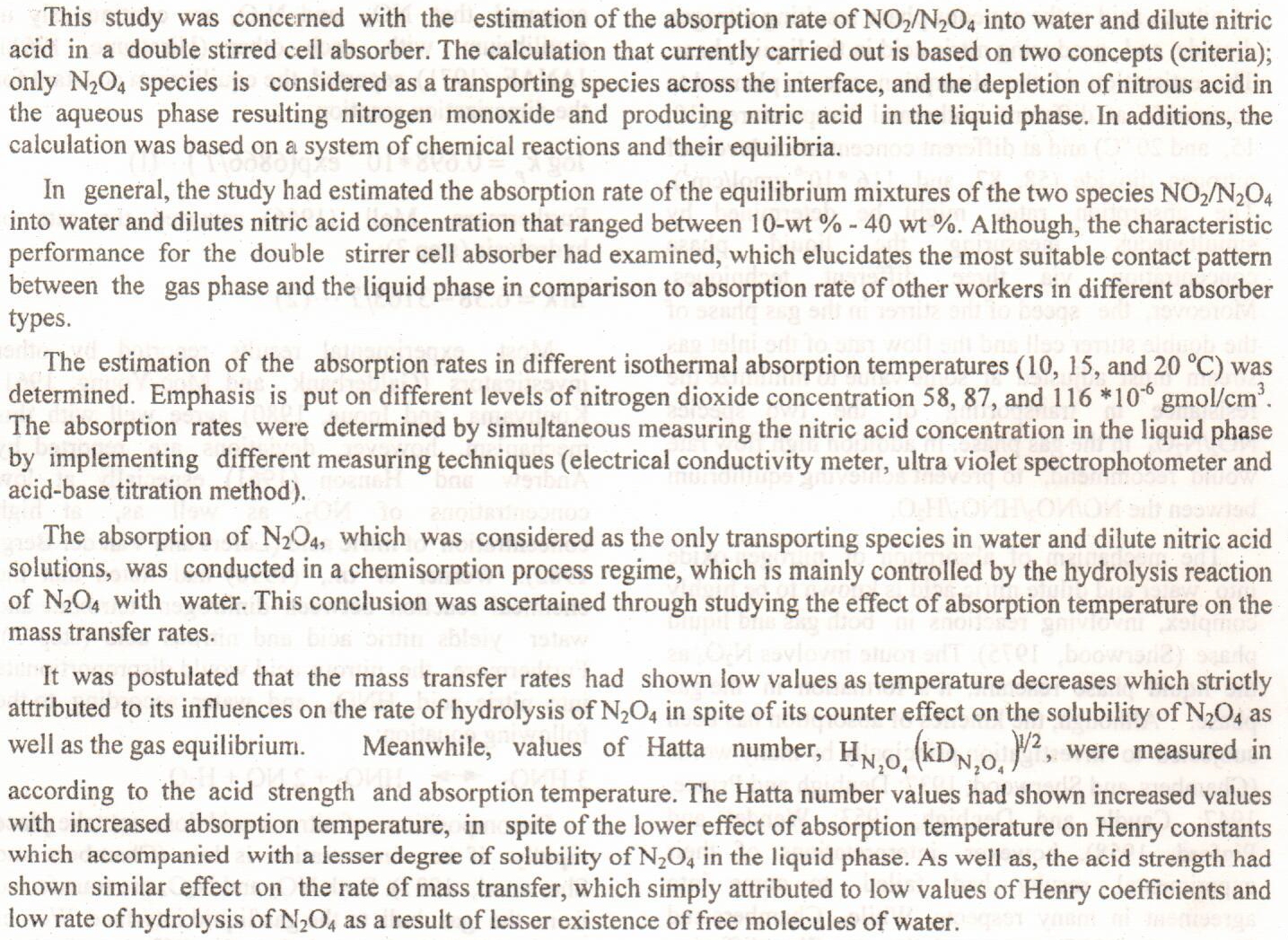

Hydrogen fuel is a good alternative to fossil fuels. It can be produced using a clean energy without contaminated emissions. This work is concerned with experimental study on hydrogen production via solar energy. Photovoltaic module is used to convert solar radiation to electrical energy. The electrical energy is used for electrolysis of water into hydrogen and oxygen by using alkaline water electrolyzer with stainless steel electrodes. A MATLAB computer program is developed to solve a four-parameter-model and predict the characteristics of PV module under Baghdad climate conditions. The hydrogen production system is tested at different NaOH mass concentration of (50,100, 200, 300) gram. The maximum hydrogen produc
... Show MoreHeavy metals contamination in aquatic ecosystems is considered one of the most important threats of aquatic life. Submerge aquatic plants Ceratophyllum demersum in its non living form used for the removal of trace elements. This article studied the ability of the fine powder of C.demersum for the removal of some heavy metals (HM) like copper, cadmium, lead and chrome from aqueous solution with in variable experimental factors. The study occupy two treatments the first included different hydrogen ions pH within a range of 4, 5,6and 8 with a constant HM concentration (1000 ppm).While the second treatment represented by using variable HM concentrations within a range of (250,500,750and 1000 ppm) with a constant pH=7.In both treatments the a
... Show MoreA simple chemistry method approach was used to synthesise new ligand derivate from L-ascorbic acid and its complexes. All of them were water-soluble and are used quite extensively in the medical and pharmaceutical fields. This study synthesised the new ligand derivative from L-ascorbic acid-base using the following steps: A 5,6-O-isopropylidene-L-ascorbic acid was prepared by reacting dry acetone with L-ascorbic acid followed by reacting it with trichloroacetic acid to yield [chloro(carboxylic)methylidene]-5,6-O-isopropylidene-L-ascorbic acid in the second stage. In the third stage, the derivative was reacted with (methyl(6-methyl-2-pyridylmethyl)amine to create a new ligand (ONMILA). This novel ligand was identified using a number
... Show More (3)
(3)
 (1)
(1)
الوصف A simple chemistry method approach was used to synthesise new ligand derivate from L-ascorbic acid and its complexes. All of them were water-soluble and are used quite extensively in the medical and pharmaceutical fields. This study synthesised the new ligand derivative from L-ascorbic acid-base using the following steps: A 5, 6-O-isopropylidene-L-ascorbic acid was prepared by reacting dry acetone with L-ascorbic acid followed by reacting it with trichloroacetic acid to yield [chloro (carboxylic) methylidene]-5, 6-O-isopropylidene-L-ascorbic acid in the second stage. In the third stage, the derivative was reacted with (methyl (6-methyl-2-pyridylmethyl) amine to create a new ligand (ONMILA). This novel ligand was identified using
... Show MoreEuropean Chemical Bulletin (ISSN 2063-5346) is a peer-reviewed journal that publishes original research papers, short communications, and review articles in all areas of chemistry. European Chemical Bulletin has eight sections, namely
The reaction of L-ascorbic acid with the tirchloroacetic acid in the presence of potassium hydroxide gave new product Bis[O,O-2,3;O,O-5,6(chlorocarboxylicmethyliden)]Lascorbic acid (H2L) which was isolated and characterized by 1H,13C-NMR, elemental analysis (C,H,N), UV-Visible and Fourier Transform Infrared (FTIR). The complexes of the ligand (H2L) with metal ions, M+2= (Cu, Co, Ni, Cd and Hg) were synthesized and characterized by FTIR, UV-Visible, molar conductance, atomic absorption, magnetic susceptibility and the molar ratio. The analysis evidence showed the binding of the metal ions with (H2L) through the bicarboxylato group manner resulting in six-coordinated metal ion. The TLC for (H2L) and complexes showed one spot for eac
... Show MoreThis study uses an environmentally friendly and low-cost synthesis method to manufacture zinc oxide nanoparticles (ZnO NPs) by using zinc sulfate. Eucalyptus leaf extract is an effective chelating and capping agent for synthesizing ZnO NPs. The structure, morphology, thermal behavior, chemical composition, and optical properties of ZnO nanoparticles were studied utilizing FT-IR, FE-SEM, EDAX, AFM, and Zeta potential analysis. The FE-SEM pictures confirmed that the ZnO NPs with a size range of (22-37) nm were crystalline and spherical. Two methods were used to prepare ZnO NPs. The first method involved calcining the resulting ZnO NPs, while the second method did not. The prepared ZnO NPs were used as adsorbents for removing acid black 210
... Show More (6)
(6)
 (3)
(3)
